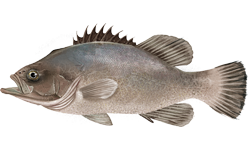
The wreckfish are a small group of ray-finned fish in the genus Polyprion, belonging to the monotypic family Polyprionidae in the order Acropomatiformes.
Ageneiogarra is a genus of freshwater ray-finned fishes belonging to the family Cyprinidae, which ncludes the carps, barbs and related fishes. The fishes in this genus are found in southeastern and eastern Asia.

Puntioplites is a genus of freshwater ray-finned fish belonging to the family Cyprinidae, the family which includes the carps, barbs, minnows and related fishes. The fishes in this genus are found in eastern Asia.

Heteromormyrus is a genus of freshwater ray-finned fishes belonging to the family Mormyridae, the elephantfishes. These fishes are found in southern and central Africa in Angola, Namibia, the Democratic Republic of the Congo and, maybe, Zimbabwe.
Chilorhinus is a small genus of marine ray-finned fishes belonging to the family Chlopsidae, the false morays. These eels occur in tropical waters
Congresox is a genus of marine ray-finned fishes belonging to the family Muraenesocidae, the pike congers. The fishes in this genus are found in the Indian and Pacific Oceans.

Jinshaia is a genus of freshwater ray-finned fishes belonging to the family Balitoridae, the loaches in this family are commonly known as hillstream loaches although this name also refers to the loaches in the family Gastromyzontidae. These loaches are endemic to China.

Plesiomyzon is a monospecific genus of freshwater ray-finned fish belonging to the family Gastromyzontidae, a group which shares the common name hillstream loaches with the family Balitoridae. The only species in the genus is Plesiomyzon baotingensis, a loach that is endemic to the river systems of Hainan.
Protomyzon is a genus of ray-finned fish belonging to the family Gastromyzontidae, commonly called the hillstream loaches, although this also refers to the loaches in the family Balitoridae. The loaches in this genus are endemic to Borneo.

Pseudogastromyzon is a genus of ray-finned fish belonging to the family Gastromyzontidae, commonly called the hillstream loaches, although this also refers to the loaches in the family Balitoridae. The loaches in this genus are found in fast-flowing streams and rivers in China.

Bangana is a genus of fish in the family Cyprinidae, the carps and minnows. It is distributed across much of southern and eastern Asia. Species live mainly in the flowing waters of tropical and subtropical rivers.
Discocheilus is a genus of freshwater ray-finned fish belonging to the family Cyprinidae, the carps, barbs, minnows and related fishes. The species which belong to this genus are endemic to China.
Luciocyprinus is a genus of freshwater ray-finned fish belonging to the family Cyprinidae, the family which includes the carps, barbs, minnows and related fishes. The fishes in this genus are found in China and Southeast Asia.

Mystacoleucus is a genus of freshwater ray-finned fish belonging to the family Cyprinidae, the family which includes the carps, barbs, minnows and related fishes. The fishes in this genus are found in Southeast Asia.

Procypris is a genus of freshwater ray-finned fish belonging to the family Cyprinidae, the family which includes the carps, barbs, minnows and related fishes. The fishes in this genus are found in eastern Asia.

Pseudohomaloptera is a genus of freshwater ray-finned fish belonging to the family Balitoridae, the river or hillstream loaches. The species in this genus are found in eastern Asia.
Diplocheilichthys jentinkii is a species of freshwater ray-finned fish belonging to the family Cyprinidae, the carps, barbs, minnows and related fishes. This species was first formally described in 1904 as Osteochilus jentinkii by the Dutch ichthyologist Canna Maria Louise Popta with its type locality given as the Bongon River in the Mahakam River basin in eastern Borneo. The specific name honours the Dutch zoologist Fredericus Anna Jentink who was the curator of the Rijksmuseum van Natuurlijke Historie, Leiden, and edited the journal in which Popta published her description. This fish is endemism to Borneo where it occurs in the upper reaches of rivers in the Kapuas River basin in West Kalimantan, Indonesia, and in Sarawak, East Malaysia.

Diplocheilichthys pleurotaenia is a species of freshwater ray-finned fish belonging to the family Cyprinidae, the carps, barbs, minnows and related fishes. This fish is found in Sumatra and was found on Java, but is thought to be extirpated from Java.

Cyclocheilos is a genus of freshwater ray-finned fishes belonging to the family Cyprinidae, the family which includes the carps, barbs and related fishes. This fishes in this genus are found in Southeast Asia.

Ceratogarra is a genus of freshwater ray-finned fish belonging to the family Cyprinidae, the family which includes the carps, barbs and related fishes. These fishes are found in southeast Asia.













